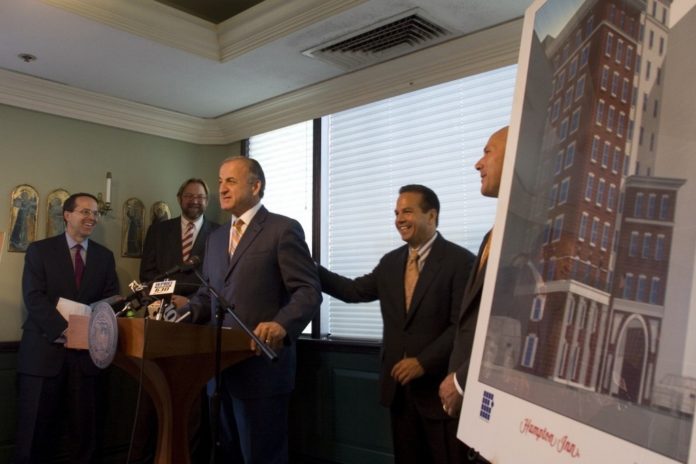
Evan Granoff, partner of Granoff Associates, said he thinks the benefits of a mid-priced hotel in the financial district of downtown Providence will extend well beyond serving a market niche that is currently underserved.
He thinks the $17 million plan his firm announced last week to redevelop the historic St. Francis Chapel at 58 Weybosset St. into a Hampton Inn & Suites hotel, along with other development projects, such as One Ten Westminster, are going to create a demand from tourists and homeowners that could support more retail and restaurants in the area.
“Combined with the growth of the colleges and influx of students into the district, we believe there will be a critical mass of demand to support a wide array of businesses,” he said at a press conference last Monday. (Granoff was referencing the Rhode Island School of Design student residences at 15 Westminster St., which houses 500 students.)
The Arcade, for example, could become more of a tourist attraction, he said. Granoff Associates owns and manages The Arcade along with the Turk’s Head and Union Trust buildings in that area.
The real estate developing company is partnering with First Bristol Corp. of Fall River to re-develop St. Francis Chapel, which Granoff Associates owns. The company is also developing the One Ten project, which includes a W luxury hotel and condominiums, with Blue Chip Properties and O’Connor Capital Properties.
Room rates at the Hampton Inn will range from $150 to $175 per night, said James J. Karam, president and CEO of First Bristol Corp. The limited-service hotel will have 115 rooms, including 38 suites, 37 king rooms and 40 standard rooms. It will also include two conference rooms, a meeting room, a fitness center and spa and high-speed Internet access, among other things.
Karam said the location is desirable because of the Monday-through-Thursday business clientele and the weekend tourist clientele it attracts.
“With [nearby] companies like Textron and the universities and Bank of America and … Citizens [Bank], we think there are a number of business people who are looking for a value-oriented product,” he said, adding that the city’s arts and culture offerings, such as WaterFire and the Dunkin’ Donuts Center, could attract weekend guests.
In addition, Karam said he believes the project will qualify for state and federal historic tax credits, which could help finance about 25 percent of the development costs for the project.
First Bristol Corp. chose Newport Collaborative Architects to design the historic renovation project because of the firm’s local experience with projects of this nature. The architecture firm will be adding a five-story building to the original 11-story building. Through it will be an archway that provides a much-needed area where cars can drop off guests and luggage, said J. Michael Abbott, principal of the firm.
“We wanted a group that could work with the historic element,” Karam said. “[Newport Collaborative] is sensitive to the needs of the historic boards and commissions. … I’m sure the project will qualify [for the tax credits] as long as we meet the guidelines in the redesign.”
First Bristol Corp. was also able to get financing from Massachusetts-based Rockland Trust at an interest rate that is 2 percent lower than the conventional rate for projects like this. The bank is providing the loan through its community development entity, which is using a federal new markets tax credit to aid in the redevelopment of urban areas, said Chris Oddleifson, president and CEO of Rockland Trust.
“Without these incentives, the project would not become a reality,” Karam said.











